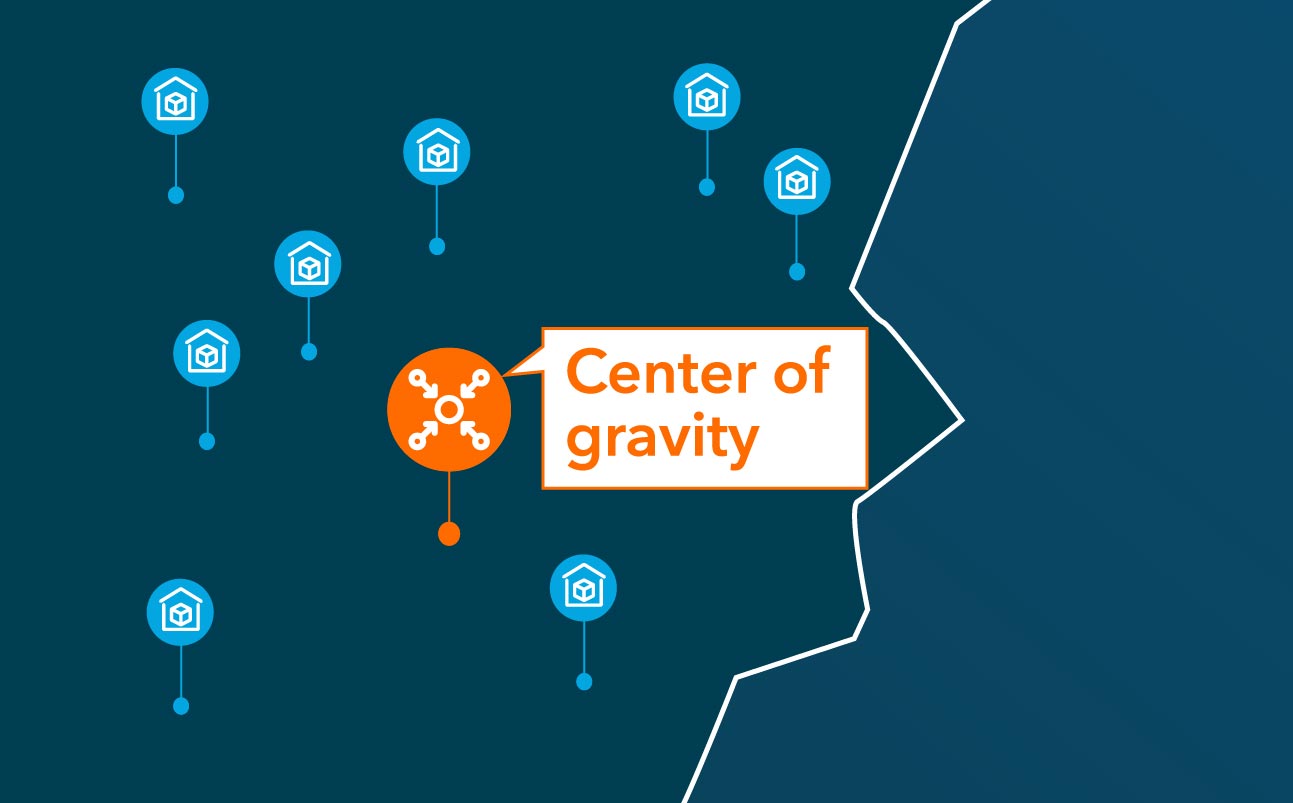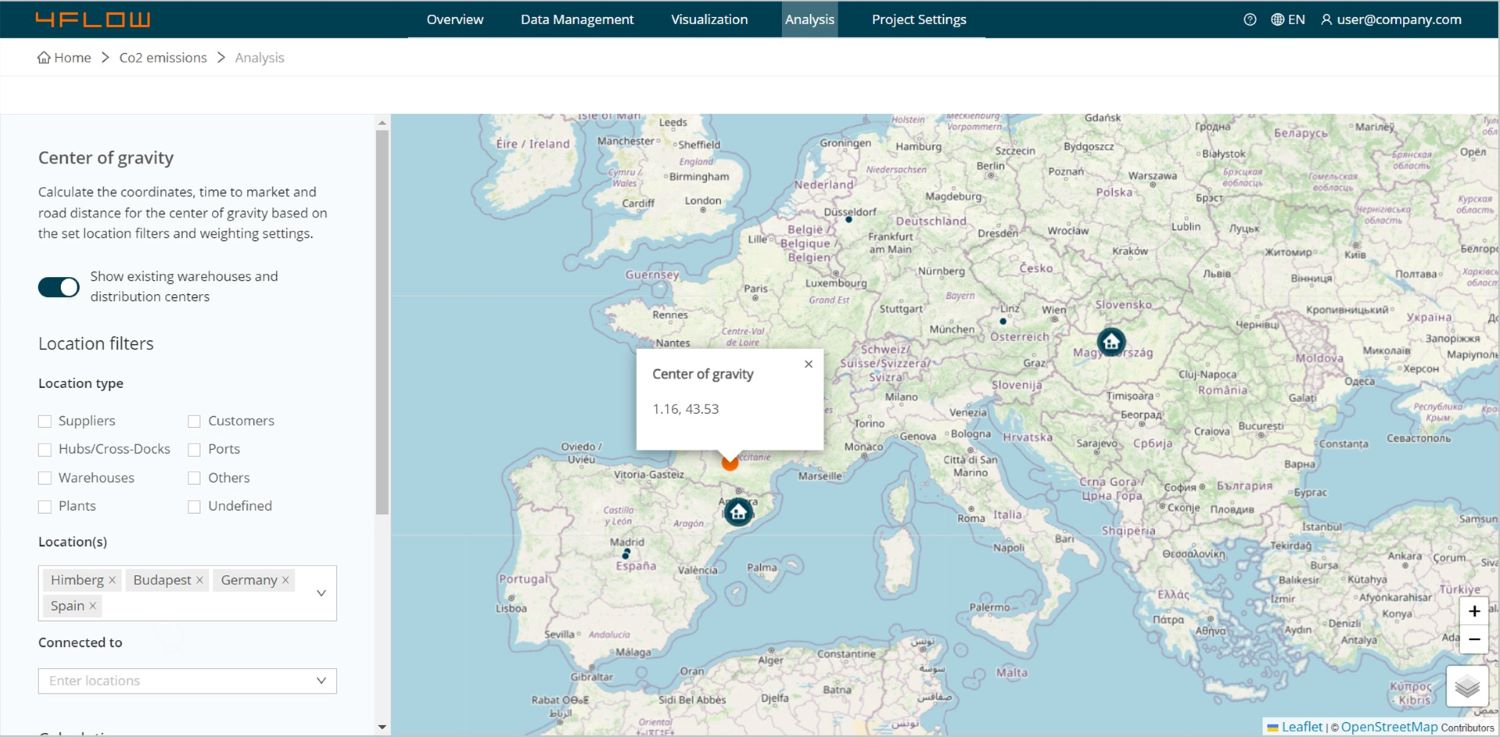- Insights & events
- Blog

Blog | January 9, 2024
Center of gravity analysis for the location of new logistics sites
Lately, supply chain professionals have begun to understand strategic network design as an ongoing process of enhancement rather than a one-time project. This shift is due largely to the dynamic nature of global supply chains and the increased speed of network optimization. As a result, there is growing demand to evaluate network footprints and determine optimal site locations. Strategic placement of distribution centers or warehouses within a network enhances supply chain efficiency and lowers transportation costs.
Center of gravity (COG) analysis is considered a classic method to find the optimal location for warehouses or distribution centers. But with the rapid development of new methods and algorithms, does COG still have a role to play in shaping your network design? Let’s take a closer look at different aspects of this method.
What is center of gravity analysis?
The center of gravity is the location with minimal total transportation costs or weighted distances from all nodes (warehouses, supply and distribution points) in a supply chain network. Distances are weighted to account for volume or frequency of transportation.
COG analysis is frequently used to determine where to build a new distribution center, fulfillment center, or warehouse, for both finished goods and component parts. Based on the locations of plants and markets, the volume of goods moved, and transportation costs, businesses can calculate the ideal location for new sites.

Center of gravity method in supply chain network optimization

Center of gravity method in supply chain network optimization
Sounds interesting? Let's get in touch!
Contact usWhen is COG analysis generally used?
Supply chains change over time through growth, changing customer behavior, global disruptions, and more. As a result, businesses need to reassess their networks. COG analysis can be a quick way to evaluate potential network changes considering factors like customer demand, transportation costs, and facility capacities.
Businesses re-evaluate their sourcing strategies to find better alternative suppliers or renegotiate contracts more frequently today than in the past. COG analysis can identify optimal warehouse locations in relation to potential new suppliers to keep costs low and maintain a competitive advantage in the market.
Mergers and acquisitions (M&A) often lead to operational redundancies and overlapping facilities like warehouses, distribution centers, or production plants. COG analysis can help determine the optimal locations for consolidation, leading to cost savings.
When a business changes its target customer service level, it might increase the amount of inventory on hand. COG analysis helps determine optimal locations to hold this inventory, ensuring it is strategically positioned close to demand points to fulfill customer requirements.
Why is COG analysis a popular technique in network design?
Simple and intuitive: Because it is easy to understand and quick to apply, COG analysis has been a common approach in supply chain network design – even before modern supply chain software, when calculations were primarily done manually using spreadsheets. The analysis is simple, as it requires minimal data input and relies mainly on geographical coordinates and the weight for each location. This information is usually readily available, and the calculations involved in COG analysis are relatively straightforward.
Initial decision support: With a simple calculation method, COG analysis provides relatively quick results, which are valuable in preliminary assessments of facility locations.
Sounds interesting? Let's get in touch!
Contact usWhat are the limitations of a manual center of gravity analysis?
Manual methods of COG analysis are primarily based on delivery distance and demand flow, but real-world decisions need to consider more variables, like seasonal demand fluctuations and costs for inbound and interplant transportation.
Manual COG calculations rely on straight-line distances and do not factor in actual road distances traveled by truck.
Actual carrier tariffs may vary by origin-destination pairs. Transportation costs can also be influenced by other factors, such as traffic conditions, tolls, the availability of capacity for given transportation modes, or even geopolitical issues. These factors are usually overlooked when doing COG analysis by spreadsheet.
Manual COG analysis focuses on the optimal site location based on geography. However, strategic considerations could be equally, if not more, important. These factors could include proximity to top suppliers, diversification of risk, and access to innovation hubs or skilled talent pools.
Manual COG analysis typically provides a single optimal location. However, in many real-world scenarios, networks might need multiple warehouse or distribution center locations to meet service level requirements.
How does COG analysis fit into today’s landscape of network design opportunities?
Recent technological development like the advancement of supply chain network design software has made center of gravity analyses more flexible. For instance, it is now possible to overcome the shortcomings mentioned above by integrating additional data points and large datasets. User-friendly platforms provide intuitive visualization of results, while some software enables users to combine center of gravity analysis with other optimization and simulation models. In this combined approach, COG helps identify a general area for a new site, and businesses can use a more detailed model to fine-tune their decision.
Combined with advanced software, COG analysis remains a useful starting point for more sophisticated analyses in supply chain network design. Software support overcomes the limitations of manual calculations and maximizes the value of COG analysis within the broad toolkit of supply chain network design methods. And thanks to the speed enabled by this software, network design including COG analysis can be revisited regularly to reflect changes to supply chains over time.


Sounds interesting? Let's get in touch!
Contact usAuthor


Jana Brandt
Senior Expert
4flow software